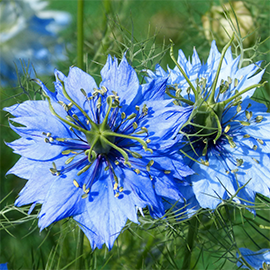I am not attempting to incite a conflict here, so kindly abstain from doing so. Everyone's views and thoughts will undoubtedly be unique, and various strokes will apply to different people. Therefore, please appreciate what others have to say, even if you disagree. If misting is so bad, how come nearly every houseplant book recommends it for certain plants?
Posted at 8:24 AM on Sep 22, 2011 by threegardeners (Brockville, Ontario, Canada - Zone 5a). With relation to the plant: One of my favorite yearly self-seeders. They self-seed and have returned reliably for the past decade. In the Fall, I collect the seed pods and disperse the seeds in various locations where I want them to grow. Respond to this remark Posted by Mindy03 (Delta KY) at 5:01 PM on April 23, 2012 concerning plant: This shrub provides pollen for honey bees. Respond to this remark
Plant Love-in-a-mist Seeds: Direct sow into weed-free seed beds that have had the top 1 inch of soil removed. Lightly rake seed into the soil. By stepping over the region, press into the earth. Maintain moisture. Grow Your Own Love-in-a-mist: Sunlight, direct or indirect. Water consumption ranges from average to minimal. Tolerates a broad range of soil types with adequate drainage. Rapidly blooms. Planting occurs in the spring. In areas with moderate winters, seeds may be be planted in the autumn for an early April flowering. To maintain a constant supply, space repeated sowings 4 weeks apart (until plants begin to self-sow). While the flowers are good for cutting, the horned seed capsules provide an element of interest to dried arrangements. Resistant to deer.
""So here's the thing," Failla explains to mbg, "it's debatable if misting is genuinely beneficial to a plant. According to some, spraying plants increases humidity. However, others claim that when you mist and the water soon evaporates, it really accomplishes nothing for the plant in the long run." With that in mind, there is much to be said about striving to optimize humidity levels for your houseplants, even if just temporarily, since most plants (particularly those native to damp and tropical locations) require greater humidity levels than those found in a normal household. And, although sprinkling the air surrounding your plant may be ineffective, going closer to the soil may provide your plant with a much-needed dosage of hydration.














